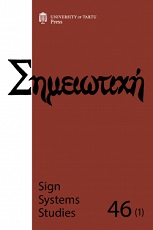Emptiness and desire in the first rule of logic
Emptiness and desire in the first rule of logic
Author(s): Jamin PelkeySubject(s): Semiotics / Semiology, Theoretical Linguistics, Semiology, Logic, Evaluation research
Published by: Tartu Ülikooli Kirjastus
Keywords: learning; growth of understanding; research; constraints; absentials; pragmaticism; logic as semiotic;
Summary/Abstract: Charles Sanders Peirce’s first rule of logic (EP 2.48, 1898) identifies the inception point of human inquiry. Taking a closer look at this principle, we find at its core a necessary relationship between emptiness and desire that underlies all genuine instances of human learning and adaptation. This composite relationship plays a critical role in the function or failure of learning but has received scant attention in the literature. As a result, the complexities of the first rule of logic are not well understood, often being mistakenly conflated with the rule’s famous corollary, ‘do not block the way of inquiry’, or passed over with cursory defi nitions, including ‘wonder’, ‘doubt’ and ‘the will to learn’. Following a background discussion highlighting the nature of reflexive inquiry and fallibilism that situate human consciousness both within and beyond animal being, I draw on multiple layers of evidence from a range of disciplines to better reveal the complex dynamics intrinsic to the first rule of logic.
Journal: Σημειωτκή - Sign Systems Studies
- Issue Year: 46/2018
- Issue No: 4
- Page Range: 467-490
- Page Count: 24
- Language: English

